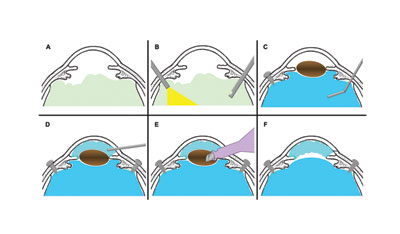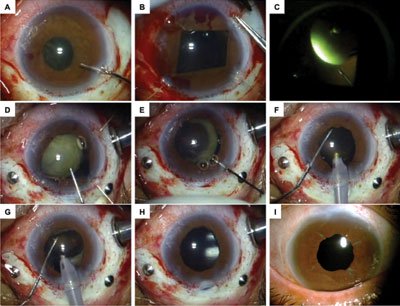Visco-perfluorocarbon sandwich technique useful for luxated hard cataractous lenses
The lens is sandwiched between an ophthalmic viscosurgical device and perfluorocarbon liquid, so phaco under lower fluidics can be safely performed.
Subluxated or dislocated cataractous lenses may be the result of trauma, complications during cataract surgery, Marfan syndrome, homocystinuria, Weill-Marchesani syndrome, Ehlers-Danlos syndrome, aniridia, sulfite oxidase deficiency or hyperlysinemia.
The majority of nontraumatic subluxated or dislocated lenses may be due to Marfan syndrome, homocystinuria or Weill-Marchesani syndrome. Glaucoma should be recognized as a frequent complication in some of these disease entities, but it is most serious in Weill-Marchesani syndrome, in which it often occurs early in life and usually remains unrecognized until significant damage has resulted. It is important to keep in mind that patients with homocystinuria are at risk for vascular thrombosis and thromboembolic events following general anesthesia, and this should be considered during the surgical planning to avoid post-anesthetic systemic complications.
Surgical management of a luxated hard cataractous lens is often challenging to the ophthalmic surgeon. The surgical objective is to remove the lens without any collateral damage to the other intraocular structures, especially the retina and the cornea, and any thermal injury to the sclera.

Thomas John
In this column, Dr. Sato describes the visco-perfluorocarbon sandwich technique to perform phacoemulsification of a luxated hard crystalline lens.
Thomas John, MD
OSN Surgical Maneuvers Editor
by Masaki Sato, MD, PhD
Several surgical techniques have been used to remove luxated cataractous lenses. For hard nuclei, large-incision intracapsular or extracapsular extraction may be necessary, which usually results in surgically induced astigmatism and other potential intraoperative complications, including iris prolapse, rhegmatogenous retinal detachment and suprachoroidal hemorrhage. In an attempt to prevent such surgical complications, small-incision or microincision surgery is recommended.
Pars plana phacofragmentation with the use of perfluorocarbon liquid (PFCL) can be performed through an enlarged sclerotomy. But the retina may be injured by the unstable, hard lens nuclear fragments. Moreover, thermal injury to the sclerotomy site and retinal dialysis may result.
The visco-perfluorocarbon sandwich technique facilitates conventional phacoemulsification of a luxated hard crystalline lens. Because the entire lens is sandwiched with an ophthalmic viscosurgical device (OVD) and PFCL, conventional phacoemulsification under lower fluidics can be performed safely without damage to the corneal endothelium and the retina.
Surgical technique
It is important to perform phacoemulsification with proper fluidics settings and within the middle of the sandwich (Figure 1). First, the soft-shell technique is performed after three-port pars plana vitrectomy (PPV). PFCL is injected into the vitreous cavity. In order to stabilize the entire lens without significant movement during phacoemulsification, an ample amount of OVD and PFCL should be injected above and beneath the lens, respectively. Under very low fluidics, phacoemulsification is performed within the sandwich, which will help the vitreous cavity retain its original volume.

Figure 1. Schematic representation of visco-perfluorocarbon sandwich technique. Preoperative appearance (a). Three-port PPV (b). Intravitreal injection of ample amount of PFCL (c). The soft-shell technique (d). Conventional phacoemulsification under very low fluidics is performed within the sandwich (e). Theoretically, both OVDs and PFCL are expected to help the vitreous cavity retain its original volume at the completion of phacoemulsification (f).
Source: Sato M
Figure 2 illustrates the surgical sequence in a case of Marfan syndrome. Because of poor mydriasis, the soft-shell technique with Viscoat (sodium chondroitin sulfate and sodium hyaluronate, Alcon) and Provisc (sodium hyaluronate, Alcon) is performed prior to PPV. Subsequently, iris retractors are used to dilate the small pupil. A standard 20-gauge PPV (cutting rate: 1,500/min; vacuum: 50 mm Hg to 150 mm Hg) is performed with a conventional viewing system. PFCL is injected to elevate the crystalline lens from the retina into the pupillary space. After all three ports are temporarily closed, a 2.75-mm superior sclerocorneal incision is made. Prior to phacoemulsification, additional Provisc is injected into the anterior chamber. PFCL is also gently added beneath the lens through the scleral pocket, so that the entire lens is slightly subluxated out of the vitreous cavity.

Figure 2. Surgical steps in a case of Marfan syndrome with a subluxated cataractous lens. The soft-shell technique (a). Iris retractors are used to dilate the small pupil (b). Intravitreal injection of ample amount of PFCL after PPV (c). Additional OVDs are injected into the anterior chamber (d). Additional PFCL is injected beneath the lens. The entire lens is subluxated out of the vitreous cavity (e). Conventional phacoemulsification under very low fluidics within the sandwich. There is good intracameral stability (f and g). The cornea remains clear after phacoemulsification. Next, a foldable IOL is transsclerally fixated, and both PFCL and OVD are removed (h). Postoperative appearance 1 month after surgery (i).
Source: Sato M
At this point, the entire lens is wrapped within the sandwich and therefore stabilized. The capsulorrhexis is unnecessary because the whole lens is phacoemulsified. Phacoemulsification using a 30° round 0.9-mm ABS mini-flared tip (Alcon) with a 0.9-mm irrigation sleeve (Alcon) is performed under very low fluidics (aspiration flow rate: 20 cc/min; phaco power: 70%; bottle height: 60 cm). The entire lens is divided into fragments and removed. With meticulous care, all the manipulation at this stage is performed in the middle of the sandwich. The intracameral stability is so good that phacoemulsification is usually performed without any significant problems. Sequentially, transscleral suture fixation of a three-piece 7-mm optic foldable acrylic IOL (VA-70AD, Hoya) is performed through a 2.75-mm sclerocorneal incision. The OVDs and PFCL are completely removed from the anterior chamber and the vitreous cavity, respectively. All three ports are sutured, but no sutures are used to close the sclerocorneal incision. Postoperatively, topical diclofenac and levofloxacin are applied four times daily for 6 weeks.
Amount of OVDs and PFCL
Due to complete luxation, the rock-hard lens easily moves around within the eye. Thus, phacoemulsification entails a higher risk of corneal endothelial damage and retinal injury. The appropriate use of OVDs and PFCL is highly effective in preventing such intraoperative complications. Using proper flow parameters, the sandwich can wrap and sustain the luxated dense lens, facilitating safer and more efficient phacoemulsification. The retinal damage by the nucleus fragments may especially cause severe complications, and this is prevented using the above technique.
Usefulness of foldable IOL
Implantation of a foldable IOL is useful for transscleral fixation after pars plana lensectomy. Following the above described surgical technique, visual rehabilitation is rapid postoperatively. Additionally, a 23- or 25-gauge microincision vitrectomy system (MIVS) has been gaining in popularity globally for the surgical treatment of various retinal diseases. The increase in the use of MIVS has been enhanced by studies that demonstrate significant reductions in postoperative astigmatism, conjunctival injection, pain and discomfort. The combination of MIVS and foldable IOL transscleral fixation may be particularly useful.
References:
- Dalma-Weiszhausz J, Franco-Cardenas V, Dalma A. A modified technique for extracting a dislocated lens with perfluorocarbon liquids and viscoelastics. Ophthalmic Surg Lasers Imaging. 2010;41(5):572-574.
- Girard LJ, Canizales R, Esnaola N, Rand WJ. Subluxated (ectopic) lenses in adults. Long-term results of pars plana lensectomy-vitrectomy by ultrasonic fragmentation with and without a phacoprosthesis. Ophthalmology. 1990;97(4):462-465.
- Omulecki W, Stolarska K, Synder A. Phacofragmentation with perfluorocarbon liquid and anterior chamber or scleral-fixated intraocular lens implantation for the management of luxated crystalline lenses. J Cataract Refract Surg. 2005;31(11):2147-2152.
- Tsai YY, Tseng SH. Transscleral fixation of foldable intraocular lens after pars plana lensectomy in eyes with a subluxated lens. J Cataract Refract Surg. 1999;25(5):722-724.
For more information:
- Thomas John, MD, is a clinical associate professor at Loyola University at Chicago and in private practice in Oak Brook, Tinley Park and Oak Lawn, Ill. He can be reached at 708-429-2223; fax: 708-429-2226; email: tjcornea@gmail.com.
- Masaki Sato, MD, PhD, is an associate professor, Department of Ophthalmology, Mito Regional Medical Education Center, Tsukuba University Hospital, Ibaraki, Japan. He can be reached at 81-292312371; fax: 81-292215137; email: masasato@md.tsukuba.ac.jp.
- Disclosures: Drs. John and Sato have no relevant financial disclosures.
